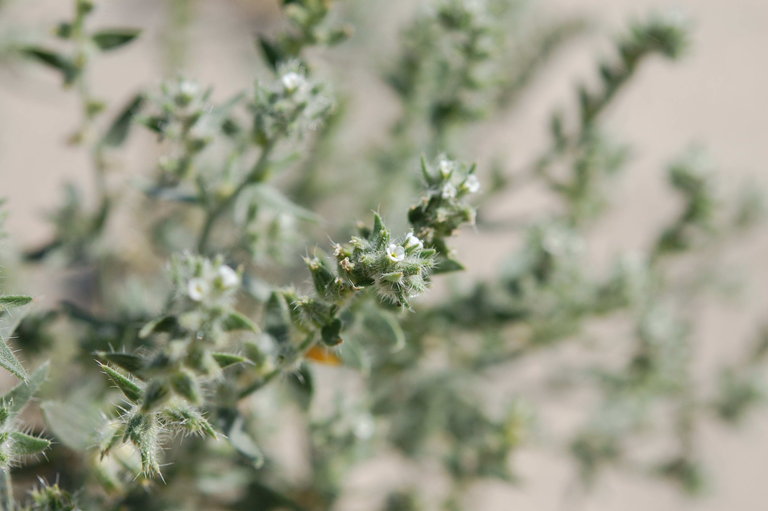Duration: Annual
Nativity: Native
Lifeform: Forb/Herb
General: Annual to short-lived perennial herbs, 10-60 cm tall; stem erect, solitary and forming a central axis but branching throughout, occasionally woody at base; herbage strigose and rough-bristly, the bristles spreading to ascending, some bulbous-based.
Leaves: Alternate; lower leaves short-petiolate and upper leaves sessile; blades 3-6 cm long, elliptic to lanceolate, covered with short, rough, bulbous-based bristles.
Flowers: White, in scorpioid racemes, these usually bractless and borne in pairs at branch tips; calyx 2 mm long in flower, persistent and extending to 3 mm in fruit, the lobes dense-bristly to rough-hairy with spreading hairs and with a thickened midvein; corolla white, salverform, deciduous, the limb 2-3 mm wide, flat, with 5 yellow appendages at the top of the tube.
Fruits: Nutlets 4, ovate to triangular, 2 mm long, dark with pale tubercles, more or less dull, the margin a flat non-papery wing, the axis extending beyond nutlets.
Ecology: Found in gravelly to rocky soils, washes, slopes and ridges, below 4,000 ft (1219 m); flowers January to May.
Distribution: w AZ, se CA, s NV; south to nw MEX.
Notes: Cryptantha is a genus of bristly herbs with white or yellow flowers in spikes that are usually 1-sided and curling like a scorpion-s tail (-scorpioid-). C. holoptera is an uncommon annual of the low deserts near the AZ/CA border; it is primarily distinguished by its nutlets which are covered by pale bumps (tubercles) and have a flat smooth wing around the margin; also look for the upright, relatively tall (usually 30-60 cm) stature of the plant; and the fruiting pedicels 1-5 mm long (other similar species have 0-1 mm pedicels in fruit).
Ethnobotany: Unknown
Synonyms: Cryptantha inaequata, Eritrichium holopterum, Johnstonella holoptera
Editor: AHazelton 2015
Etymology: Cryptantha comes from the Greek krypto, "hidden," and anthos, "flower," a reference to the first described species in the genus which has inconspicuous flowers that self-fertilize without opening; holoptera is from the Greek words holos, -whole, entire- and pteron, -wing,- referring to the wing on the nutlets.





